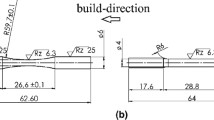Abstract
Selective laser melting (SLM), as a metalworking additive manufacturing technique, received considerable attention from industry and academia due to unprecedented design freedom and overall balanced material properties. However, the fatigue behavior of SLM-processed materials often suffers from local imperfections such as micron-sized pores. In order to enable robust designs of SLM components used in an industrial environment, further research regarding process-induced porosity and its impact on the fatigue behavior is required. Hence, this study aims at a transfer of fatigue prediction models, established for conventional process-routes, to the field of SLM materials. By using high-resolution computed tomography, load increase tests, and electron microscopy, it is shown that pore-based fatigue strength predictions for a titanium alloy TiAl6V4 have become feasible. However, the obtained accuracies are subjected to scatter, which is probably caused by the high defect density even present in SLM materials manufactured following optimized processing routes. Based on thorough examination of crack surfaces and crack initiation sites, respectively, implications for optimization of prediction accuracy of the models in focus are deduced.







Similar content being viewed by others
References
G.N. Levy, R. Schindel, and J.P. Kruth: CIRP Ann., 2003, vol. 52, pp. 589–609.
K.V. Wong and A. Hernandez: ISRN Mech. Eng., 2012, vol. 2012, pp. 1–10.
I. Campbell, D.L. Bourell, and I. Gibson: Rapid Prototyping J., 2012, vol. 18, pp. 255–58.
S. Masood and W. Song: Mater. Des., 2004, vol. 25, pp. 587–94.
D.L. Bourell, T.J. Watt, D.K. Leigh, and B. Fulcher: Phys. Procedia, 2014, vol. 56, pp. 147–56.
W.E. Frazier: J. Mater. Eng. Perform., 2014, vol. 23, pp. 1917–28.
L.E. Murr, S.M. Gaytan, D.A. Ramirez, E. Martinez, J. Hernandez, K.N. Amato, P.W. Shindo, F.R. Medina, and R.B. Wicker: J. Mater. Sci. Technol., 2012, vol. 28, pp. 1–14.
S. Leuders, M. Thöne, A. Riemer, T. Niendorf, T. Tröster, H.A. Richard, and H.J. Maier: Int. J. Fatigue, 2013, vol. 48, pp. 300–07.
A. Riemer, S. Leuders, M. Thöne, H.A. Richard, T. Tröster, and T. Niendorf: Eng. Fract. Mech., 2014, vol. 120, pp. 15–25.
B. Vrancken, L. Thijs, J.-P. Kruth, and J. van Humbeeck: J. Alloys Compd., 2012, vol. 541, pp. 177–85.
L. Thijs, F. Verhaeghe, T. Craeghs, J. van Humbeeck, and J.-P. Kruth: Acta Mater., 2010, vol. 58, pp. 3303–12.
T. Niendorf and F. Brenne: Mater. Charact., 2013, vol. 85, pp. 57–63.
B. Song, S. Dong, Q. Liu, H. Liao, and C. Coddet: Mater. Des., 2014, vol. 54, pp. 727–33.
M. Shiomi, K. Osakada, K. Nakamura, T. Yamashita, and F. Abe: CIRP Ann., 2004, vol. 53, pp. 195–98.
G. Strano, L. Hao, R.M. Everson, and K.E. Evans: J. Mater. Process. Technol., 2013, vol. 213, pp. 589–97.
I. Yadroitsev and I. Smurov: Phys. Procedia, 2011, vol. 12, pp. 264–70.
S. Leuders, T. Lieneke, S. Lammers, T. Tröster, and T. Niendorf: J. Mater. Res., 2014, vol. 29, pp. 1911–19.
E. Brandl, U. Heckenberger, V. Holzinger, and D. Buchbinder: Mater. Des., 2012, vol. 34, pp. 159–69.
E. Wycisk, A. Solbach, S. Siddique, D. Herzog, F. Walther, and C. Emmelmann: Phys. Procedia, 2014, vol. 56, pp. 371–78.
Y. Murakami and M. Endo: Int. J. Fatigue, 1994, vol. 16, pp. 163–82.
H. Danninger and B. Weiss: J. Mater. Process. Technol., 2003, 143-144, pp. 179–84.
Y. Murakami: Metal fatigue: Effects of Small Defects and Nonmetallic Inclusions, Elsevier, Oxford, Boston, 2002, pp. 57-74.
T. Mann: Int. J. Fatigue, 2007, vol. 29, pp. 1393–1401.
A. Spagnoli: Chaos, Solitons Fractals, 2004, vol. 22, pp. 589–98.
D. Dini, D. Nowell, and I.N. Dyson: Tribol. Int., 2006, vol. 39, pp. 1158–65.
Acknowledgments
The authors would like to thank the Direct Manufacturing Research Center (DMRC), its industry partners and the state of North Rhine Westphalia for financial support of the present study.
Author information
Authors and Affiliations
Corresponding author
Additional information
Manuscript submitted December 16, 2014.
Rights and permissions
About this article
Cite this article
Leuders, S., Vollmer, M., Brenne, F. et al. Fatigue Strength Prediction for Titanium Alloy TiAl6V4 Manufactured by Selective Laser Melting. Metall Mater Trans A 46, 3816–3823 (2015). https://doi.org/10.1007/s11661-015-2864-x
Published:
Issue Date:
DOI: https://doi.org/10.1007/s11661-015-2864-x




